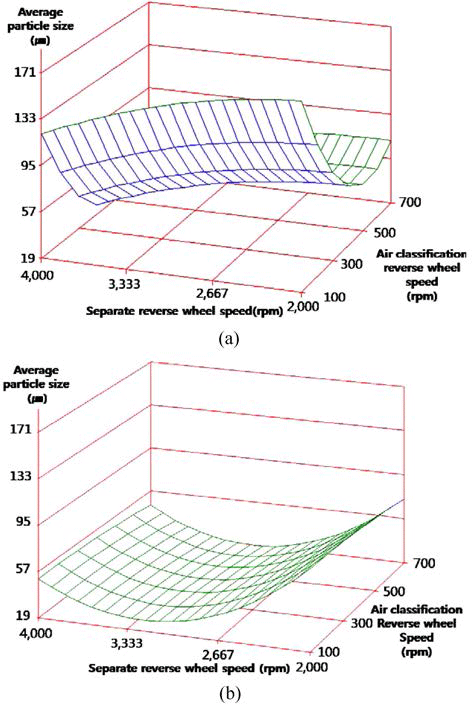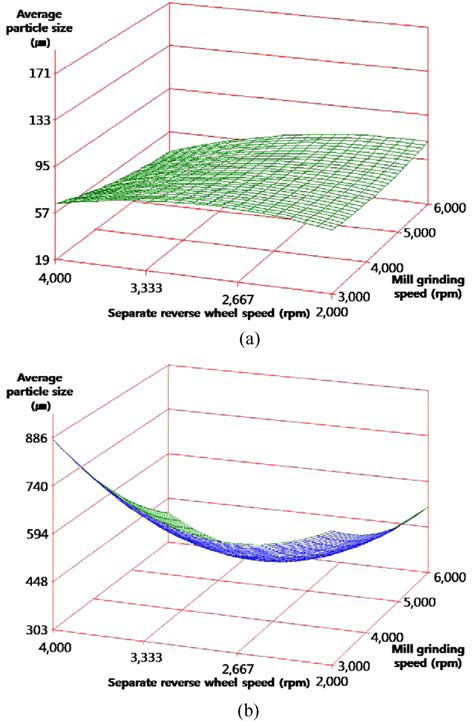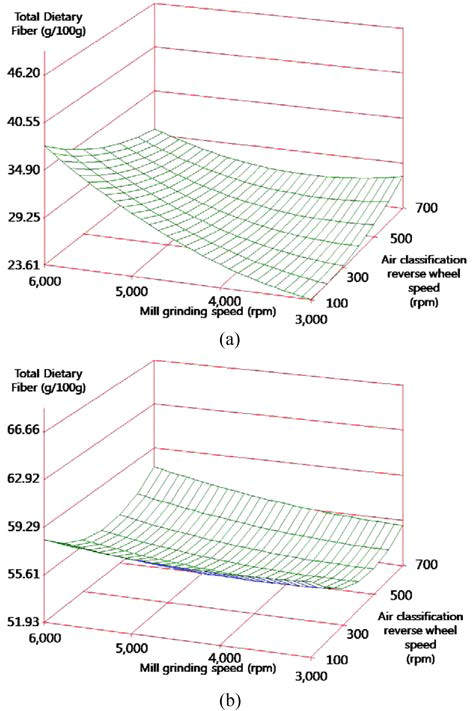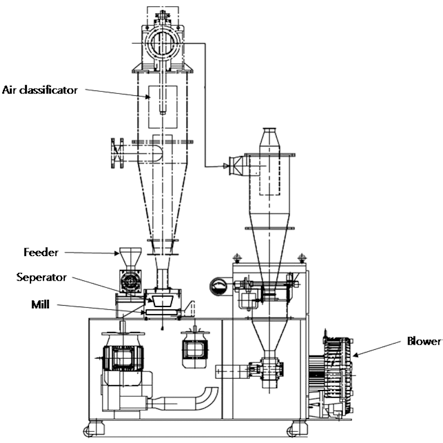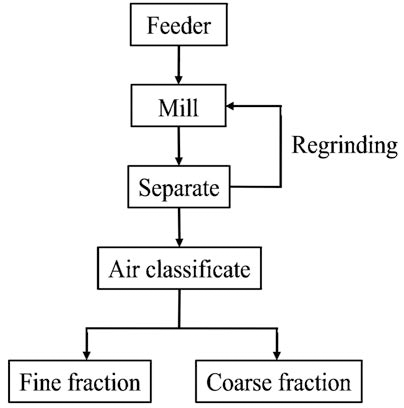Article
초미분쇄 공기분급 시스템으로 분리한 밀기울 분급물의 특성
이재강1,2, 박진아1, 최용현1, 김영화1,2, 류기형2,*
Characteristics of Wheat Bran Classified by Ultra-Fine Grinding and Air-Classification Systems
Jae-Kang Lee1,2, Jin-A Park1, Yong-Hyun Choi1, Young-Wha Kim1,2, Gi-Hyung Ryu2,*
1R&D Center, DongA One Co., Ltd
2Department of Food Science and Technology, Kongju National University
*Corresponding Author: Gi Hyung Ryu, Department of Food Science and Technology, Kongju National University, Yesan, Choongnam 340-800, Korea, Tel: +82-41-330-1484; Fax: +82-41-335-5944, E-mail:
ghryu@kongju.ac.kr
© Korean Society for Food Engineering. All Rights Reserved. This is an Open-Access article distributed under the terms of the Creative Commons Attribution Non-Commercial License (http://creativecommons.org/licenses/by-nc/3.0/) which permits unrestricted non-commercial use, distribution, and reproduction in any medium, provided the original work is properly cited.
Received: Feb 18, 2014; Revised: May 7, 2014; Accepted: Jun 18, 2014
Abstract
Using an air-classification system equipped with both ultra-fine grinding and air-classification, wheat bran was ground at a mill grinding speed of 3,800, 4,800, 5,800 rpm and a separator reverse wheel speed of 2,500, 3,000 and 3,500 rpm. Ground bran was air-classified with a reverse wheel speed of 200, 400 and 600 rpm. The effects of mill grinding, separation, and classification wheel speeds on the characteristics of air-classified bran were examined by a threelevel, three-factor full factorial experimental design and a response surface regression analysis. The highest value of the object variables was determined via canonical analysis. For the fraction ratio of classified bran products, both the fine and coarse fraction of brans were significantly affected by the mill grinding speed (p<0.01), separator reverse wheel speed (p<0.01), and air-classification reverse wheel speed (p<0.01). For average particle sizes of classified bran products, the fine fractions were significantly affected by only the air-classification reverse wheel speed (p<0.01), whereas the coarse fractions were affected by the mill grinding speed (p<0.01) and the separator reverse wheel speed (p<0.01). With regards to the total dietary fiber of classified bran products, the fine fraction products were affected by the mill grinding wheel speed (p<0.01) and the air-classification reverse wheel speed (p<0.01), while the coarse fraction products were affected by the mill grinding speed (p<0.01), separator reverse wheel speed (p<0.01) and the air-classification reverse wheel speed (p<0.01). The optimal conditions for the highest total dietary fiber content, lowest average particle size and highest classification ratio in wheat bran were a 5,500.3 rpm mill grinding speed, 2,500 rpm separator reverse wheel speed and a 600 rpm air-classification reverse wheel speed, in which the total dietary fiber content was estimated to be 39.52 g/100 g in coarse fraction.
Keywords: ultrafine-grinding mill; air classification; wheat bran; dietary fiber
서 론
밀기울(wheat bran)은 소맥분을 생산하면서 얻게 되는 부산물로, 밀을 제분시 약 15% 생산되며, 외피와 내피, 종 피, 히알린층, 호분층과 일부 배유 부분의 전분질로 구성되 어 있다. 각각의 층은 서로 다른 구조와 구성성분의 특징 이 있는데, 외피와 내피는 헤테로자일란(heteroxylan)과 불 용성 식이섬유인 셀룰로오스로 구성되어 있고, 종피는 지 질 성분이 풍부한 소수성 층으로 구성되어 있으며, 호분층 (aleurone layer)은 아라비노자일란(arabinoxylan)과 베타글 루칸(β-glucan)으로 구성된 두꺼운 세포벽으로, 파이테이트 (phytate), 단백질 미량 영양소 등의 생리 활성 화합물을 둘러 싸는 세포로 구성되어 있어(Mackeown-Eyssen et al., 1985; Schneeman, 1987; Yang et al., 1987; Key et al., 1997) 영양 적 가치가 높지만 대부분 대부분 사료로 이용되고 있는 실 정이다(Staniforth et al., 1991).
현대 사회가 산업화, 도시화, 세계화 되어감에 따라 한국 인의 식생활은 점점 간편화, 서구화 되어가고 있으며 식품 산업의 발달로 인하여 가공식품, 인스턴트식품, 냉동식품 등의 섭취가 많아지면서 식이섬유의 섭취량은 점차 감소하 고 있는 현상을 보이고 있다(Kim et al., 2004). 식이섬유 섭취는 암 예방 효과가 있으며(Rhim et al., 2004), 소장 내용물의 점도를 증가시키고 다른 영양소와 음식물 성분이 확산되는 것을 억제하여 흡수를 조절함으로서 포도당이나 콜레스테롤의 흡수 속도를 억제하고(Lee et al., 2005), 변 비 증상을 갖고 있는 사람들이 섭취시 배변 횟수를 증가시 키고 대장 체적 시간을 감소시키며, 변의 부피를 증가시키는 등 변비 증상을 호전 시킬 수 있다(Fincher et al., 1986; Pomeranz, 1988; Evers et al., 1998; Kim et al., 2006; Atwell, 2010).
최근 식품소재의 미세화 연구에 의하면 마이크론 기술과 나노 기술이 사람의 건강을 개선 시키기 위한 기능성 식품 으로의 큰 잠재성을 보이며(Chen et al., 2006), 고 식이섬 유 작물의 입자 크기의 감소는 그 구조와 표면적과 기능성 성질을 변화시켜 장내 건강 향상에 유리한 효과로 작용하 였다고 보고하였으며(Chau et al., 2007), 미세하게 분쇄된 식이섬유를 햄스터에게 섭취 시킬 때 triglyceride, 콜레스 테롤과 지방간 흡착을 낮춰주는 효과를 보였으며, 이는 불 용성 식이섬유의 물리화학적 성질과 특성에 입자 크기가 중 요한 인자로 작용하였다고 보고하였다(Chou et al., 2008; Wu et al., 2009). 또한 실험실용 볼밀로 밀기울을 분쇄 후 arabinoxylan을 물 추출할 경우 추출 함량이 4%에서 61%로 증가하였으며(Wu et al., 2009), 옥수수 껍질의 입자가 작을 수록 비타민 B군(niacin, pantothenic acid, thiamin)을 섭취 할 때 생리 활성이 높게 작용한다고 보고 되었다(Yu et al., 1993).
식품을 미세하게 분쇄하기 위하여 기존의 방식인 햄머 밀, 핀 밀, 롤러 밀이 분쇄기의 특성상 마찰에 의한 분쇄열에 의 하여 열에 불완전한 성분의 파괴가 이루어 질 수 있으나 (Seo et al., 2011), 저온 분쇄는 입자의 재응집 및 열에 민 감한 화합물의 파괴를 제한한다고 보고되었으며(Wilczek et al., 2004), 기류식 분쇄기는 기류의 흐름에 따른 냉각효과로 원료의 색, 향, 풍미의 변화, 영양성분 파괴를 방지하고 고 섬유질 함유 원료식품의 미분화가 가능한 것으로 보고되었 다(Kang et al., 2001). 그리고, 공기분급 장치는 산업에서 일반적으로 건조된 가루를 분급하기 위하여 사용하며 (Worthen, 2001), 단백질, 전분, 무기질 등 특정성분을 농축 또는 감소시킬 수 있다고 보고되어 있고(Kon et al., 1977), 외피의 섬유질이 조분 분획쪽으로 분급되는 연구결과가 있 었다(King & Dietz, 1987).
따라서 본 연구는 기류분쇄기와 공기분급 장비를 동시에 수행할 수 있는 장치를 사용하여 밀기울을 미분쇄한 뒤 공 기분급하여 회수된 여러 분획들의 분급비율, 평균입자 크 기, 총 식이섬유 함량을 조사하여 식품 원료로서의 이용 가능성을 제시하고자 수행되었다.
재료 및 방법
실험재료
기류분쇄 공기분급 밀기울의 제조에 사용된 시료는 밀 원맥을 제분하는 과정에서 부산물로 생산되는 밀기울 (Wheat bram, Korea Flour Mills Co., Seoul, Korea)로 중력 분 생산시 주로 사용되는 원맥인 A.S.W(Australian standard white)의 밀기울을 사용하였다.
연속식 기류 분쇄 공기 분급 공정
미세분급 밀기울의 제조는 연속식 기류분쇄 공기분급기 (DMC-5, Daehyun Eng, Danjin, Korea)를 이용하였으며, 기류분쇄 조건은 mill grinding speed와 separator reverse wheel speed이며 공기분급 조건은 공기분급기(air classification)의 reverse wheel speed를 조절하였다. 분쇄 및 분급 조건은 Table 1과 같으며 분쇄 및 분급 장치는 blower를 통하여 공기의 흐름이 생기며, feeder를 통해 투 입된 시료는 mill에서 1차 분쇄하였다. Blower의 풍압에 의하여 상승하는 시료는 중량 따라 separator에서 1차 선별 되어 무거운 시료는 separator을 통과하는 중량이 될 때까지 mill로 반복하여 분쇄되었다. 1차 선별된 시료는 공기분급 기(air classificator)의 휠 회전속도에 의하여 비중에 따라 분 급되었다. 공기분급기를 통과한 시료는 미분, 통과하지 못한 시료는 조분으로 분급되었다(Fig. 1, 2).
Table 1.
Coded level for independent variables use in experimental design.
|
Xi Independent variables |
Levels |
|
-1 |
0 |
1 |
|
X1 Mill grinding speed (rpm) |
3,800 |
4,800 |
5,800 |
|
X2 Separator reverse wheel speed (rpm) |
2,500 |
3,000 |
3,500 |
|
X3 Air Classification reverse wheel speed (rpm) |
200 |
400 |
600 |
Download Excel Table
분급 비율
초미세분쇄 및 공기 분급시 각각 분급되는 미분(fine fraction)과 조분(coarse fraction) 각각의 분획을 1분간 샘플 링 하였다. 각 분획의 평균 무게를 3회씩 반복 측정하였고, 분급물 총중량에 대한 각 분획물 중량의 비로 분급 비율을 계산하였다.
평균입자분석
각 분획의 평균입자 분석은 laser diffraction particle size analyser(LS I3 320, Becman Coulter, Brea, CA, U.S.A.)를 사용하여 3회씩 반복 실험 하였다. 본 입자분석장치는 입 자에 레이저 빛을 조사하면 빛은 투과, 반사, 흡수, 산란되 고, 산란된 빛은 다시 반사, 굴절, 회절 현상을 일으키며, 산란된 빛의 세기 및 산란각도가 검출기에 감지되어 측정 하는 장비이다. 측정 시 유체는 에탄올을 사용하였으며, 측 정 시 초음파 처리를 하여 시료의 분산성을 증가시켰다. 분석시 에탄올과 시료의 혼합 비율(obscuration)은 11%로 시료에 30초간 레이저를 조사하여 검출되는 산란각도를 측 정후 분석장치 소프트웨어에서 자동으로 계산하였으며, 입 자 크기는 0 μm에서 2,000 μm범위에서 실시하였다.
총 식이섬유 정량 분석
분급 시료의 총 식이섬유 정량은 AOAC의 방법(1977)을 이용하여 측정하였다. 시료 1 g을 각각의 비커에 넣고, pH 6.0의 인산완충용액 50 mL을 넣은 뒤 0.1 mL의 α-amylase 를 혼합한 뒤 95°C 수조에서 15분간 반응시켰다. 실온 냉각 후 pH를 7.5±0.2가 되도록 0.275 N NaOH를 가한 다음, 버 퍼에 희석된 5 mg/mL의 protease를 각각의 비커에 넣고 60°C 항온수조에서 30분간 반응시킨 후 실온 냉각을 하였 다. pH 4.0~4.6이 되도록 0.325M HCl을 넣어 준 뒤, 0.1mL의 amyloglucosidase를 넣어주었고 그 후 30분간 반응 시켰다. 반응을 멈추기 위하여 95%의 에탄올을 넣어 주었다 . 그리고 미리 규조토를 도포한 유리여과기를 사용하여 여과 후 105°C의 dry oven에서 건조 및 항량시켜 평균 잔사 중량 을 측정한 다음 각각의 잔사의 단백질과 회분값 중량을 측 정하여 그 값을 감하여 총 식이섬유 함량을 측정하였다.
완전요인 실험계획
밀기울의 기류 분쇄 및 공기분급 공정변수에 따른 종속 변수의 변화를 결정하기 위한 3인자 완전요인계획에 의해 사용하였으며 분쇄 및 분급 공정변수에 따른 압출성형물의 특성은 SAS program(Statistical Analysis System, ver 9.3, SAS Institute Inc., Cary, NC, USA)과 미니탭(Minitab, release 17, Minitab Inc., State College, PA, USA)을 사용 하여 실험계획법 반응표면 회귀분석으로 통계처리 및 공정 최적화를 예측하였다. 반응표면 분석에서 독립변수는 mill grinding speed(X1), separate reverse wheel speed(X2), air classification reverse wheel speed(X3)이며, 각 변수는 -1, 0, 1의 세 가지 수준으로 부호화 하였다(Table 1). 반응변 수(Yn)로 분급 분획물의 분급 비율, 평균입자, 총 식이섬유 함량으로 하였다. 세 가지 독립변수(X1, X2, X3)에 대한 2 차 회귀모형은 식 (1)과 같다.
여기서 Y는 반응변수, X1, X2, X3은 독립변수, b0는 절편, bn은 회귀계수이다.
결과 및 고찰
분급 비율
기류식 분쇄기를 이용한 분쇄 조건(mill grinding speed, severate reverse wheel speed)과 공기분급 조건(air classification reverse wheel speed)에 따른 분급 수율의 반응표면 분석 결과 는 Table 2, 다중회귀분석(multiple regression analysis)결과는 Table 3와 같다. 분급 비율의 R2는 모두 0.911 으로 높은 상관관계를 보여주며 설정한 모델식으로 결과를 예측할 수 있었다. 또한 분쇄기 회전속도, 분리기 휠 회전 속도, 공기 분급 휠 회전속도 모두 높은 유의 확율(p<0.05)을 나타내 분급 비율에 높은 영향을 미치는 것으로 나타났다. 또한, 초미분쇄기를 이용한 분쇄와 공기분급 장치를 사용한 분급 에 따른 각각의 반응표면 분석 결과 분획의 수율에 대한 반응표면 회귀식은 Table 4과 같다.
Table 2.
Experimental data of wheat bran grinded and classified under different conditions based on full factorial design for response surface analysis.
|
Coded level1) |
Fine fraction2) |
Coarse fraction2) |
|
X1
|
X2
|
X3
|
Classification ratio (%) |
Average particle size (µm) |
Total dietary fiber (g/100 g) |
Classification ratio (%) |
Average particle size (µm) |
Total dietary fiber (g/100 g) |
|
-1 |
-1 |
-1 |
30.04±1.381) |
118.9±1.42 |
33.40±0.87 |
69.96±1.38 |
547.9±1.74 |
58.24±0.42 |
|
0 |
17.73±1.81 |
60.09±1.72 |
33.40±0.44 |
82.27±1.81 |
599.6±2.04 |
54.63±0.38 |
|
1 |
17.27±1.16 |
57.97±1.55 |
32.78±0.62 |
82.73±1.16 |
514.1±1.92 |
53.54±0.29 |
|
0 |
-1 |
23.93±1.12 |
101.6±1.45 |
31.16±0.33 |
76.07±1.12 |
540.2±1.47 |
55.18±0.34 |
|
0 |
20.03±1.33 |
41.95±1.88 |
32.51±0.47 |
79.97±1.33 |
545.8±1.11 |
53.75±0.27 |
|
1 |
23.00±1.12 |
62.92±1.47 |
32.74±0.49 |
77.00±1.12 |
523.7±1.27 |
52.62±0.48 |
|
1 |
-1 |
19.26±1.80 |
95.36±1.59 |
32.84±0.72 |
80.74±1.80 |
569.8±1.44 |
55.37±0.51 |
|
0 |
15.43±1.94 |
37.55±1.81 |
31.66±0.43 |
84.57±1.94 |
605.8±1.21 |
51.03±0.37 |
|
1 |
9.85±1.99 |
43.9±1.14 |
30.84±0.44 |
90.15±1.99 |
565.3±1.44 |
53.49±0.29 |
|
0 |
-1 |
-1 |
35.27±2.03 |
104.7±1.44 |
36.71±0.27 |
64.73±2.03 |
460.6±1.27 |
56.80±0.61 |
|
0 |
24.55±1.88 |
54.05±1.27 |
34.09±0.39 |
75.45±1.88 |
432.0±1.80 |
55.67±0.72 |
|
1 |
21.26±1.74 |
47.25±2.07 |
30.45±0.38 |
78.74±1.74 |
437.7±2.17 |
57.04±0.41 |
|
0 |
-1 |
37.42±1.27 |
119.5±1.92 |
39.23±0.44 |
62.58±1.27 |
415.9±1.47 |
56.34±0.55 |
|
0 |
28.40±2.07 |
49.66±1.48 |
35.66±0.73 |
71.60±2.07 |
410.2±1.24 |
54.53±0.72 |
|
1 |
24.88±2.01 |
51.81±2.37 |
33.40±0.71 |
75.12±2.01 |
414.5±1.35 |
54.49±0.58 |
|
1 |
-1 |
21.00±1.79 |
111.9±2.21 |
34.51±0.35 |
79.00±1.79 |
448.0±1.42 |
53.69±0.67 |
|
0 |
12.90±1.82 |
46.42±2.44 |
33.46±0.36 |
87.10±1.82 |
491.5±1.18 |
55.13±0.49 |
|
1 |
15.80±1.45 |
42.07±1.74 |
29.82±0.54 |
84.20±1.45 |
465.5±1.27 |
54.29±0.44 |
|
1 |
-1 |
-1 |
57.89±1.44 |
129.2±2.08 |
42.87±0.25 |
42.11±1.44 |
413.7±1.81 |
60.99±0.38 |
|
0 |
39.36±2.57 |
68.84±1.98 |
34.61±0.77 |
60.64±2.57 |
405.2±1.22 |
58.30±0.72 |
|
1 |
39.58±2.25 |
62.21±1.49 |
34.12±0.32 |
60.42±2.25 |
422.5±2.47 |
58.16±0.77 |
|
0 |
-1 |
51.94±1.98 |
101.5±1.46 |
42.77±0.84 |
48.06±1.98 |
385.4±2.41 |
57.00±0.48 |
|
0 |
48.55±1.88 |
52.51±1.27 |
37.44±0.63 |
51.45±1.88 |
315.6±2.29 |
54.62±0.44 |
|
1 |
23.50±2.52 |
48.1±1.28 |
38.58±0.72 |
76.50±2.52 |
316.9±3.21 |
56.16±0.83 |
|
1 |
-1 |
39.07±1.88 |
87.01±2.21 |
38.64±0.24 |
60.93±1.88 |
380.0±1.41 |
57.19±0.72 |
|
0 |
34.56±2.71 |
52.46±1.92 |
37.04±0.39 |
65.44±2.71 |
309.8±2.28 |
55.51±0.28 |
|
1 |
28.24±2.44 |
40.09±1.48 |
35.08±0.68 |
71.76±2.44 |
357.1±2.74 |
54.14±0.44 |
Download Excel Table
Table 3.
Analysis of variance showing effects of treatment variables as linear or quadratic terms and interaction effects on response variables of classification ratio
|
Source |
Degree of freedom |
Fine fraction |
Coarse fraction |
|
F value |
Prov>F |
F value |
Prov>F |
|
Model |
9 |
19.22 |
<0.0001 |
19.39 |
<0.0001 |
|
Liner |
3 |
49.94 |
<0.0001 |
50.32 |
<0.0001 |
|
Quadratic |
3 |
5.32 |
0.0091 |
5.41 |
0.0085 |
|
Cross |
3 |
2.41 |
0.1027 |
2.45 |
0.0984 |
|
R2
|
0.911 |
0.911 |
|
X11) |
4 |
27.18 |
<0.0001 |
27.42 |
<0.0001 |
|
X22) |
4 |
7.38 |
0.0012 |
7.43 |
0.0012 |
|
X33) |
4 |
10.50 |
0.0002 |
10.63 |
0.0002 |
Download Excel Table
Table 4.
Polynomial equation calculated by RSM program for air-classified fraction of wheat bran
|
|
Response |
The second order polynomial1) |
R2
|
|
Fine fraction |
Classification Ratio (%) |
Y1=-60.28889-0.0279X1+0.10662X2-0.052X3+0.000005X12-0.000019X22+0.000049X32
|
0.9105 |
|
Average particle size (µm) |
Y2=228.2783+0.0102X1-0.0067X2- 0.7074X3+0.0000004X12+0.0000001X22+0.000693X32
|
0.9364 |
|
Total dietary Fiber (g/100 g) |
Y3=-6.7915-0.005860X1+0.0354X2-0.0034X3
|
0.8461 |
|
Coarse fraction |
Classification Ratio (%) |
Y4=161.6555+0.028X1-0.0177X2+0.0516X3-0.000005X12+0.000019X22-0.00005X32
|
0.9113 |
|
Average particle size (µm) |
Y5=2098.299-0.1488X1-0.177X2-0.0215X3+0.00002X12+0.000153X22-0.000073X32
|
0.9327 |
|
Total dietary Fiber (g/100 g) |
Y6=89.2924+0.00088X1-0.0188X2-0.0374X3
|
0.8170 |
Download Excel Table
미분의 경우 분쇄기 회전속도가 높을수록 물리적 마찰에 의하여 분급 비율이 높아졌으며, 공기분급의 경우 분쇄기 회전속도가 낮고 공기분급 휠 회전속도가 증가할수록 분급 비율이 높아졌으나, 분쇄 속도가 높을 경우 공기분급 휠 회전속도가 증가할수록 분급 비율이 낮아졌다(Fig. 3). Ku et al.(1996)은 초미세분쇄한 대두피의 경우 각피층(cuticle) 은 잘 분쇄되지 않아 큰 입자를 유지하고, 내부층은 비교 적 분쇄가 용이하여 공기분급 휠 회전속도가 낮은 경우는 작은 입자로 분쇄된 내부층과 비교적 작게 분쇄된 각피층 도 함께 미분획으로 회수된다고 설명하였고, Ku et al. (1998)은 공기분급 휠 회전속도가 높을수록 조분획의의 수 율이 높았다고 보고하여 본 연구 결과와 동일 하였다.
Fig. 3.
Response surface plot of fine (a) and coarse (b) fraction classification ratio as input function of mill and air classification reverse wheel speed at constant separate revers wheel speed (3,000 rpm).
Download Original Figure
평균입자
기류식 분쇄기를 이용한 분쇄 조건과 공기분급 조건에 따 른 평균입자크기의 다중회귀분석 결과는 Table 5와 같다. 공정 조건에 따른 미분과 조분 분급물의 평균입자 크기의 R2는 각각 0.9364와 0.9327로 매우 높은 수준을 보여, 설 정한 실험 조건이 자료에 적합됨을 확인할 수 있었다. 분 리기 휠 회전속도가 평균입자에 미치는 영향은 미분 분급 물(p<0.05)과 조분 분급물(p<0.01) 모두 영향을 주었으며, 공기분급 휠 회전속도는 미분 분급물(p<0.01)의 평균입자 크기에 높은 영향을 주었고 분쇄기 회전속도는 조분 분급 물(p<0.01)의 평균입자 크기에 높은 영향을 미치는 것으로 나타났다. 분쇄 및 분급 조건에 따른 분획물의 평균입자 크기의 반응표면 회귀식은 Table 3과 같다.
Table 5.
Analysis of variance showing effects of treatment variables as linear or quadratic terms and interaction effects on response variables of average particle size.
|
Source |
Degree of freedom |
Fine fraction |
Coarse fraction |
|
F value |
Prov>F |
F value |
Prov>F |
|
Model |
9 |
27.83 |
<0.0001 |
26.20 |
<0.0001 |
|
Liner |
3 |
64.42 |
<0.0001 |
70.86 |
<0.0001 |
|
Quadratic |
3 |
18.73 |
<0.0001 |
4.94 |
0.0121 |
|
Cross |
3 |
0.33 |
0.8025 |
2.80 |
0.0716 |
|
R2
|
0.9364 |
0.9327 |
|
X11) |
4 |
0.26 |
0.9015 |
55.61 |
<0.0001 |
|
X22) |
4 |
3.81 |
0.0217 |
4.98 |
0.0077 |
|
X33) |
4 |
58.79 |
<0.0001 |
0.45 |
0.7686 |
Download Excel Table
미분의 경우 분리기 휠 회전속도가 감소할수록 평균입자 크기가 증가하였고 공기분급 휠 회전속도가 증가할수록 평 균입자 크기가 감소하다가 400 rpm에서 다시 증가하는 경 향을 나타냈다(Fig. 4). 이는 분리기 휠 회전속도가 증가할 수록 재분쇄가 이루어졌으며, 공기분급은 입자의 비중의 차이에 의한 것이므로 외피(pericarp)과 호분(aleurone)의 비 중 차이에 의한 것으로 판단되어 진다. Lee et al.(2006)은 메밀의 분쇄 분급시 분쇄 선속도의 증가로 인해 초미립자 의 분급 효율이 원활하게 되어 비표면적이 증가되어 입자 가 미립화되는 경향을 볼 수 있었다고 보고하였다. 본 실 험에서도 유사한 결과가 나타났으며, 입자 크기별 분리를 위한 최적의 점을 예측할 수 있었다.
Fig. 4.
Response surface plot of fine fraction average particle size as input function of separate reverse wheel speed and air classificatory reverse wheel speed at constant mill grinding speed (4,800 rpm).
Download Original Figure
조분의 경우 분리기 휠 회전 속도가 증가할수록 평균입 자 크기가 증가하였다(Fig. 5). 이는 밀기울이 분쇄 후 미 분 분급의 분획물의 증가와 blower의 풍압으로 인하여 조 분 분급물의 크기가 큰 상태로 분급되어진 것으로 판단되 었으며, Park et al.(1993)에 의하면 분급기 휠 회전속도가 증가 할수록 분획의 입자 모양은 구형에 가까워지므로 유 지 대체제로 활용될 가능성을 시사하였다.
Fig. 5.
Response surface plot of coarse fraction average particle size as input function of separate reverse wheel speed and mill grinding speed at constant separate reverse wheel speed (3,000 rpm).
Download Original Figure
총 식이섬유
기류식 분쇄기를 이용한 분쇄 조건과 공기분급 조건에 따른 평균입자크기의 다중회귀분석 결과는 Table 6과 같다. 공정 조건에 따른 미분과 조분 분급물의 평균입자 크기의 R2는 각각 0.8461과 0.8170으로 높은 상관관계를 보여주며 설정한 모델식으로 결과를 예측 할 수 있었다. 분쇄기 회 전속도와 공기분급 휠 회전속도는 미분 분급물(p<0.01)의 총 식이섬유 함량에 영향을 주었고, 조분 분급물(p<0.01)은 세 가지 공정 조건 모두 총 식이섬유 함량에 모두 영향을 주었다. 분쇄 및 분급 조건에 따른 분획물의 평균입자 크 기의 반응표면 회귀식은 Table 3과 같다.
Table 6.
Analysis of variance showing effects of treatment variables as linear or quadratic terms and interaction effects on response variables of total dietary fiber.
|
Source |
Degree of freedom |
Fine fraction |
Coarse fraction |
|
F value |
Prov>F |
F value |
Prov>F |
|
Model |
9 |
10.38 |
<0.0001 |
8.43 |
<0.0001 |
|
Liner |
3 |
25.24 |
<0.0001 |
21.80 |
<0.0001 |
|
Quadratic |
3 |
3.07 |
0.0560 |
2.78 |
0.0727 |
|
Cross |
3 |
2.84 |
0.0691 |
0.72 |
0.5541 |
|
R2
|
0.8461 |
0.8170 |
|
X11) |
4 |
15.03 |
<0.0001 |
7.18 |
0.0014 |
|
X22) |
4 |
2.27 |
0.1045 |
7.52 |
0.0011 |
|
X33) |
4 |
8.19 |
0.0007 |
4.81 |
0.0089 |
Download Excel Table
미분의 경우 분쇄기 회전속도가 증가하고 공기분급기 회 전속도가 감소할수록 총 식이섬유 함량이 증가하였고, 조분 의 경우 분쇄기 회전 속도가 증가하고 공기분급 휠 회전속 도가 증가할수록 총 식이섬유 함량이 증가하였다(Fig. 6). 이는 분쇄기 회전속도가 높아 분쇄율이 높아 상대적으로 입 자가 작을 경우 분쇄율이 호분보다 낮은 외피의 함량이 높 은 것으로 판단되어 진다. Park et al.(1995)은 초미세 분쇄 한 찹쌀분말을 분급할 경우 분급물의 총 식이섬유 함량의 차이가 없다고 보고하였으나, 이는 밀기울의 성분 조성상의 특징과 차이가 있는 것으로 생각되며, Ku et al. (1996)에 의하면 조분획에서 총 식이섬유 함량이 미분획 보다 높게 나왔으며, 공기분급 휠 회전속도가 증가할수록 총 식이섬유 함량이 증가하여 본 연구 결과와 일치하였다.
Fig. 6.
Response surface plot of fine (a) and coarse (b) fraction classification total dietary fiber as input function of mill grinding speed and air classification reverse wheel speed at constant separate reverse wheel speed (3,000 rpm).
Download Original Figure
공정 최적화
식이섬유 소재의 미세화를 위한 대량 생산 공정의 최적 화를 위하여 미니탭의 반응 최적화 도구를 사용하여 공정 최적화를 예측하였다. 식이섬유 함량과 분급 비율을 최고 점으로 하고, 평균 입자 크기를 최소점으로 설정한 뒤 예 측된 반응 최적점은 Fig. 7과 같았다. 미분 분급물은 mill grinding speed 5,800 rpm, separate reverse wheel speed 2954.6 rpm 그리고 air classification reverse wheel speed 349.5 rpm에서 총 식이섬유 함량 39.52 g/100 g, 평균입자 63.05 μm, 분급비율 44.98%로 예측되었다. 조분 분급물은 mill grinding speed 5,500 rpm, separate reverse wheel speed 2,500 rpm 그리고 air classification reverse wheel speed 600 rpm에서 총 식이섬유 함량 57.48 g/100 g, 평균입자 402.62 μm, 분급비율 70.64%로 예측되었다.
Fig. 7.
Optimization plot of fine (a) and coarse (b) fraction classification total dietary fiber, average particle size and classification ratio as input function of mill grinding speed (X1), separate reverse wheel speed (X2) and air classification reverse wheel speed (X3).
Download Original Figure
요 약
본 연구는 밀기울을 초미분쇄기와 공기분급을 동시에 수 행하는 설비를 사용하여 분쇄기 회전속도 3,800, 4,800, 5,800 rpm, 분리기 회전속도 2,500, 3,000, 3,500 rpm으로 분 쇄하고, 공기분급기 회전속도 200, 400, 600 rpm으로 분쇄 된 밀기울을 공기분급한 각 분급물의 특성을 살펴보았다. 완전요인 실험계획에 의하여 획득한 데이터는 반응표면 회 귀 분석법으로 통계처리 후 정준분석을 실시하여 목적변수 의 최고값을 결정하였다. 분급 비율은 미분 분급물과 조분 분급물 모두 분쇄기 회전속도, 분리기 휠 회전속도, 공기분 급 휠 회전속도에 유의적으로 영향을 받았다. 분급물 평균 입자 크기는 미분의 경우 분급기 휠 회전속도의 영향을 받 았지만, 조분의 경우 분쇄기 회전속도와 분리기 휠 회전속 도의 영향을 받았다. 총 식이섬유는 미분의 경우 분쇄기 회전속도와 공기분급 휠 회전속도의 영향을 받았고, 조분 의 경우 분쇄기 회전속도), 분리기 휠 회전속도, 공기분급 휠 회전속도(의 영향을 받았다. 미세화된 식이섬유 소재의 대량 생산을 위하여 공정 최적화를 실시한 결과 미분 분급 물은 mill grinding speed 5,800 rpm, separate reverse wheel speed 2,954.6 rpm 그리고 air classification reverse wheel speed 349.5 rpm에서 총 식이섬유 함량 39.52 g/100 g, 평균입자 63.05 μm, 분급비율 44.98%로 예측되었다. 조분 분 급물은 mill grinding speed 5,500 rpm, separate reverse wheel speed 2,500 rpm 그리고 air classification reverse wheel speed 600 rpm에서 총 식이섬유 함량 57.48 g/100 g, 평균입자 402.62 μm, 분급비율 70.64%로 예측되어, 조분 분 급물을 통한 식이섬유 강화 식품 소재로서의 가능성을 발견 할 수 있었다.
감사의 글
본 연구는 농림수산식품기술기획평가원의 고부가가치식 품기술개발사업(과제번호: 112117-02-SB010)의 지원에 의 한 연구결과의 일부로 이에 감사 드립니다.
REFERENCES
AOAC Official Methods of Analysis of AOAC. 19774th edWashington D. C. USAAssociation of Official Analytical Chemists.

Atwell B. Aleurone definition ready for membership review. Cereal Foods World. 2010; 55 p. 149.

Chau CF, Wu SC, Lee MH. Physicochemical changes upon micronization process positively improve the intestinal healthenhancement ability of carrot insoluble fibre. Food Chem. 2007; 104 p. 1569-1574.

Chou SY, Chien PJ, Chau CF. Particle size reduction effectively enhances the cholesterol-lowering activities of carrot insoluble fiber and cellulose. J. Agric. Food Chem. 2008; 56 p. 10994-10998.

Chen H, Weiss J, Shahidi F. Nanotechnology in nutraceuticals and functional foods. Food Technol. 2006; 3 p. 30-36.

Evers AD, Reed M. Some novel observations by scanning electron microscopy on the seed coat and nucellus of the mature wheat grain. Cereal Chem. 1988; 65 p. 81-85.

GB FincherBA Stone Cell walls and their components in cereal grain technology. In: Pomeranz Y, editor. Advances in Cereal Science and Technology. 1986; 8 St Paul, MN: American Association of Cereal Chem. p. 207-295.

Kang WS, Choi SG. Effect of vane shape on air pressure in air fluid mill for food processing. J. Biosystems Eng. 2001; 6 p. 245-250.

Key SH, Ha MJ, Lee HS, Yun JS, Kim CI. Study on food intake and food consumption pattern of adults as a part of total diet study. Korean. J. Nutr. 1997; 30 p. 61-74.

Kim JY, Kim OY, Yoo HJ, Kim TI, Kim WH, Yoon YD, Lee JH. Effects of fiber supplements on functional constipation. Korean. J. Nutr. 2006; 39 p. 35-43.

Kim TI, Park SJ, Choi CH, Lee SK, Kim WH. Effect of earmushroom (auricularia) in functional constipation. Korean. J. Gastroenterol. 2004; 44 p. 34-41.

King RO, Dietz HM. Air classification of rape seed meal. Cereal Chem. 1987; 64 p. 411-413.

Kon S, Sanchuk DW, Jackson R, Huxsoll CC. Air classification of bean flour. J. Food Proc. Preserv. 1977; 1 p. 69-77.

Ku KH, Park DJ, Kim SH. Characteristics and application of soybean hull fractions obtained by microparticulation/air-classification. Korean. J. Food Sci. Technol. 1996; 28 p. 506-513.

Ku KH, Park DJ. Cowpea starch extraction process using microparticulation/air classification technology. Korean. J. Food Sci. Technol. 1998; 30 p. 118-124.

Lee BH, Cho KD. Effects of herb and fiber-rich dietary supplement on body weight, body fat, blood lipid fractions and bowel habits in collegians. J. Korean Soc. Food Sci. Nutr. 2005; 34 p. 644-651.

Lee KY, Jang TG, Kang WS. Air classification of buck-wheat using impeller of turbo mill. Food Eng. Prog. 2006; 10 p. 14-22.

Mackeown-Eyssen GE, Bright SE. Dietary factors in colon cancer international relationship. Nutr Cancer. 1985; 6 p. 160-170.

Official Methods of Analysis of AOAC International, section12.1.07, method 960.52. 1997; 116th edition.

Park DJ, Ku KH, Mok CK. Characteristics of glutinous rice fractions and improvement of Yoogwa processing by microparticulation/air-classification. Korean. J. Food Sci. Technol. 1995; 27 p. 1008-1012.

Park DJ, Ku KH, Mok CK. Microparticulation/air classification of rice bran: characteristics and application. Korean. J. Food Sci. Technol. 1993; 25 p. 769-774.

Y Pomeranz Chemical composition of kernel structures. In: Pomeranz Y, editor. Wheat: Chemistry and Technology. 1988; St Paul, MN: AACC. p. 97-158.

Rhim YT, Kang SY, Kim JD, Kim SS, Kim JW, Lee CY, Kim JM. Effects of functional food including dietary fiber supplementation on body composition concerning obesity and defecation satifaction of women. Korea Sport Research. 2004; 15 p. 903-910.

Schneeman BO. Soluble vs insoluble fiber-different physiological responses. Food Technol. 1987; 41 p. 81-82.

Seo MC, Ko JY, Song SB, Lee JS, Kang Jr, Kwak DY, Oh BG, Yoon YN, Nam MH, Jeong HD, Woo KS. Antioxidant compounds and activities of foxtail millet, proso millet and sorghum with different pulverizing method. Korean Soc. Food Sci. Nutr. 2011; 40 p. 790-797.

Staniforth DH, Baird IM, Fowler J, Lister RE. The effect of dietary fibre on upper and lower gastro-intestinal transit times and faecal bulking. J. Int. Med. Res. 1991; 19 p. 228-233.

Wilczek M, Bertling J, Hintemann D. Particle size reduction effectively enhances the intestinal health-promotion ability of an orange insoluble fiber in hamsters. J. Food Sci. 2007; 72 p. S618-S621.

Worthen RA. Centrifugal air classification of fine particles using rotating disks. PhD Thesis. 2001; The University of Florida p. 1-101.

Wu SC, Wu SH, Chau CF. Improvement of the hypocholesterolemic activities of two common fruit fibers by micronization processing. J. Agric. Food Chem. 2009; 57 p. 5610-5614.

Yang S, Yu SJ. Effect of dietary fiber supplement on antidepressant induced constipapation in depressed inpatients. J. Korean Acad. Psych. Mental Health Nurs. 1996; 5 p. 13-26.

Yu BH, Kies C. Niacin, thiamin, and pantothenic-acid bioavailability to humans from maize bran as affected by milling and particle-size. Plant Foods Hum. Nutr. 1993; 43 p. 87-95.


